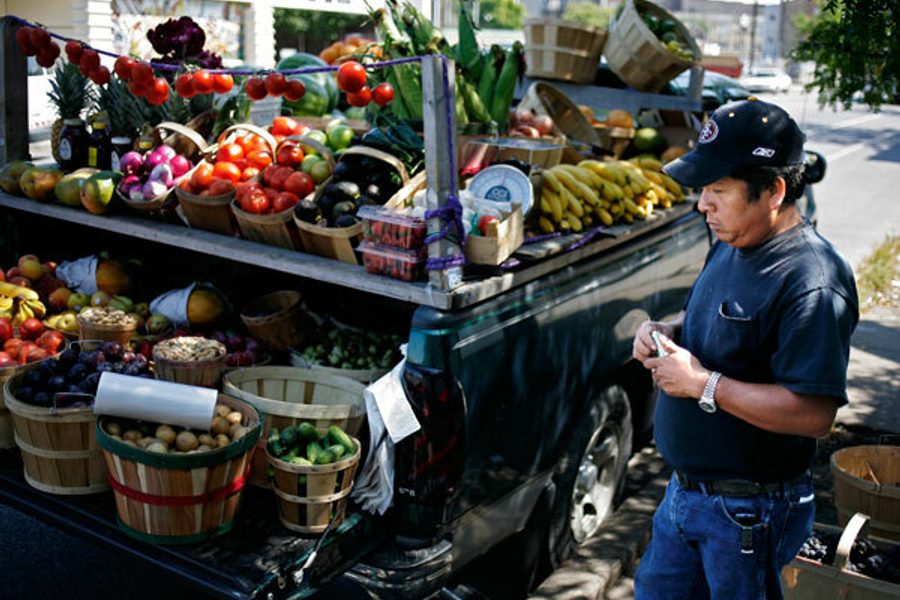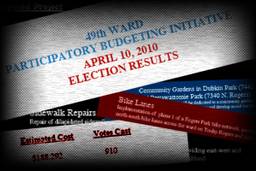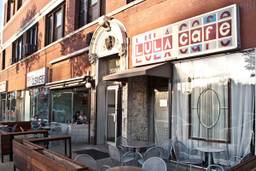Taking It to the Streets
Vendors battle bureaucracy for their place in the Second City.
Robin Peterson

When Americans go shopping or out to eat, they generally head for a store or a restaurant. But in many parts of the world, including some U.S. neighborhoods, the first place people go for food and other necessities is to the street. From kebab stands to open-air flea markets, street vendors offer consumers a cheap, convenient alternative to storefront businesses. For vendors, the work is a flexible, efficient and, at times, off-the-record way to earn cash.
But in the highly regulated modern city, hawking food or socks on the sidewalk is seen as subversive. Strict health codes and licensing requirements leave many vendors trapped in legal limbo. In Chicago, for instance, the only available city-wide vending license prohibits the sale of food that is cooked or sliced. This forces the city’s legions of tamale, paleta (popsicle) and elote(roasted corn) vendors to operate outside the law and risk fines of up to $1,000.
Jose Tafoya has received three fines of $250 for selling tamales, etole (hot chocolate) and elotes from his cart on 26th Street, a bustling commercial district in Chicago’s Mexican-American neighborhood of Little Village. As the owner of a small construction company with a family of four, Tafoya says street vending is a way “to make money to live” – an extra job on the weekends and during the winter, when construction work is scarce.
Last year, Tafoya saw a sign on the wall of a grocery store advertising the Asociaci – n de Vendedores Ambulantes (AVA – Street Vendors Association). Formed in response to a 1993 police crackdown on Little Village vendors, the AVA has fought – thus far unsuccessfully – to pass an ordinance that would enable Chicago vendors to sell cooked food legally.
“It’s difficult because there’s no one out there to help us politically,” says Tafoya, who joined the AVA and now serves as its vice president. To try to amass some clout, the organization has been meeting with the chambers of commerce of 18th, 26th and 47th Streets – all centers of vendor activity. The group has also met with three aldermen in the hope that one of them will sponsor a favorable ordinance.
“The Street Vendors Association does not want the police to just tolerate them,” says Martin Unzueta, head of Chicago Worker and Community Rights, which has been working with the AVA for the past year. “We want to sell and be in good standing with the city.” To this end, Unzueta says, he’s been helping the vendors get the only city license that exists for them – to sell whole fruit and vegetables – as well as take a food sanitation class and register in the state as small businesses so that they can pay taxes.
Who owns the street?
Some opposition to the vendors comes from storefront businesses that resent what they see as unfair competition. “They say we are hurting 26th Street restaurants because we sell etole and tamales in the morning,” Unzueta says. “But we sell only from 5 to 10 a.m., and the restaurants open at 10 a.m.” Unzueta believes, as do many researchers, that vendors serve a different customer base than the restaurants. “There’s no comparison between elotes and dinner,” he says.
Alfonso Morales, a sociology professor at the University of Madison-Wisconsin and co-founder of the Openair Market Network, says, “Storefront business will be skeptical of vendors. Then they’ll see the vendor typically brings more foot traffic. The two will learn to get along because the business is better for everybody.”
Besides small storefront businesses, there are larger forces at work in city policy, often with interests that conflict with the vendors’. “The biggest source of shutdowns is that there is some developer who wants to invest, to build upper-scale housing in the area,” says Steve Balkin, an economics professor at Roosevelt University and co-founder of the Openair Market Network with Morales. “When a developer says, ‘I want you, alderman, to get rid of these vendors if I’m going to invest money here,’ the alderman calls the health department and says, ‘Check on these vendors.’ ”
Second City syndrome
Chicago didn’t always persecute its street vendors. Back in 1912, a city ordinance created the Maxwell Street Market, where licensed peddlers could sell their goods seven days of the week. The area became a thriving commercial hub, attracting low-income and minority entrepreneurs, many of them recent immigrants. “What I saw in the Maxwell Street Market was a hotbed of entrepreneurial micro-capitalism,” Balkin says. “I saw poor people with very little skills who were able to start little businesses at the market and generate some extra income. Eventually some were able to go off and start substantial businesses.”
In 1994, over the protests of vendors and preservationists, Mayor Richard M. Daley chose to demolish Maxwell Street to accommodate an expansion of the University of Illinois-Chicago campus. The market was moved several blocks away and now takes place only on Sundays. “The mayor didn’t want street vendors anywhere near the Loop,” Balkin says. “The Loop and places near it are to be an extension of bourgeois suburban America.”
But for many people, including Balkin, street vendors are part of a city’s appeal. “I think one of the hallmarks of a world-class city is that they have an exciting street life,” he says.
Even New York, which presents itself as a world-class city, makes it difficult to negotiate the street vendor license system, according to Sean Basinski, founder of the Street Vendor Project, an organization of NYC-based vendors. New York City has capped the number of licenses it issues, giving rise to a booming black market in them, and its courts address 59,000 vending-related cases every year. “The rules are very difficult to understand, and usually have nothing to do with health and safety,” he says. “There are powerful organizations who want to control how the sidewalk works – usually businesses or real-estate interests.”
A free market?
“I see two competing forms of freedom in our country,” says Mark Weinberg, an attorney and former vendor who has defended panhandlers, street vendors and street performers against the City of Chicago. “There’s the technocratic, bureaucratic notion of freedom, in which government controls the public space, which is comforting to people because it guarantees there will never be any surprises. The other kind of freedom is more spontaneous and anarchic – it says the public space is for everybody. I think it cuts deep to the type of society we want to live in.”
Viewed through this dichotomy, a street vendor license is an ambiguous benefit. “If they’re legalized, the city will know about each one, and they can add extra regulations to put them out of business,” Balkin says.
Regulated or not, street vending is integral to many cultures, and it’s unlikely to disappear anytime soon. “In Mexico, vendors sell tamales and elotes in front of businesses, and they never have problems,” Tafoya says. As long as Chicago is an immigrant destination, the city that birthed Maxwell Street Market will be a home to vendors as well.
As Morales points out, “more and more cities across the United States are embracing public markets – as tools of economic development, as a source of food security – for a lot of the same reasons cities used public markets as policy tools 100 years ago.”
GET INVOLVED:
Openair Market Network
I hope you found this article important. Before you leave, I want to ask you to consider supporting our work with a donation. In These Times needs readers like you to help sustain our mission. We don’t depend on—or want—corporate advertising or deep-pocketed billionaires to fund our journalism. We’re supported by you, the reader, so we can focus on covering the issues that matter most to the progressive movement without fear or compromise.
Our work isn’t hidden behind a paywall because of people like you who support our journalism. We want to keep it that way. If you value the work we do and the movements we cover, please consider donating to In These Times.








